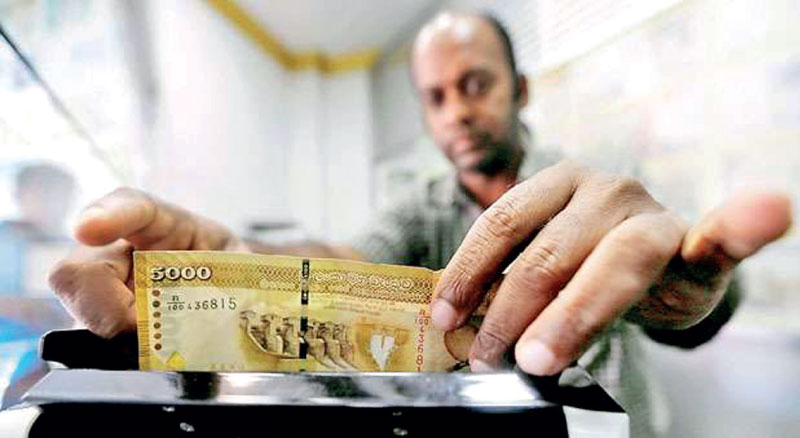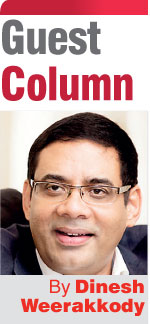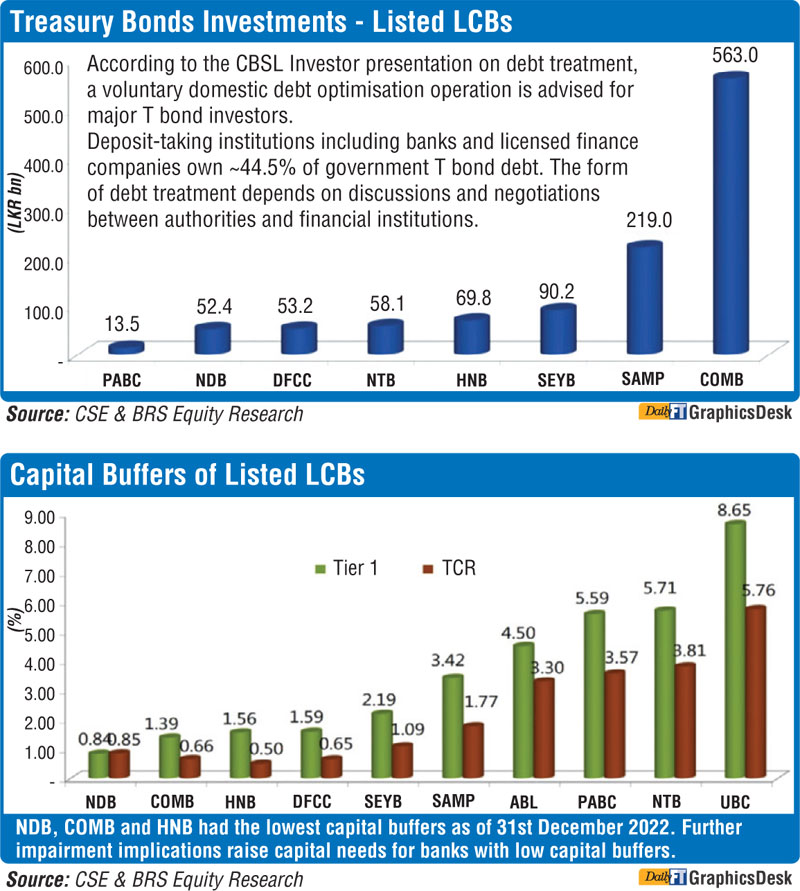Thursday Apr 03, 2025
Thursday Apr 03, 2025
Monday, 15 May 2023 02:00 - - {{hitsCtrl.values.hits}}

There is ample evidence that if the regulators do the right thing, depositors, taxpayers, etc. can be safeguarded and the banking sector need not go into a crisis
 The restructuring of our sovereign debt is primarily driven by the GFN (Gross financing needs), the forward Sovereign Debt Perimeter, the forward Debt Service to GDP and other factors that dominate the IMF’s DSA (Debt sustainability assessment) and is a critical component of the IMF’s EFF. The benefits to Sri Lanka in achieving these DSA metrics have been clearly spelt out and understood and the EFF is the enabler to restarting Sri Lanka’s growth and poverty alleviation trajectory as well as its macroeconomic and banking/financial system stability. The enabler of these metrics is the IMF. They will work closely with the GOSL MoF/Treasury towards a credible composite sovereign debt restructuring and structural macroeconomic stability whilst keeping the country’s MoF/Treasury afloat (as opposed to sovereign bankruptcy) with the EFF and multilateral funding expectations being met.
The restructuring of our sovereign debt is primarily driven by the GFN (Gross financing needs), the forward Sovereign Debt Perimeter, the forward Debt Service to GDP and other factors that dominate the IMF’s DSA (Debt sustainability assessment) and is a critical component of the IMF’s EFF. The benefits to Sri Lanka in achieving these DSA metrics have been clearly spelt out and understood and the EFF is the enabler to restarting Sri Lanka’s growth and poverty alleviation trajectory as well as its macroeconomic and banking/financial system stability. The enabler of these metrics is the IMF. They will work closely with the GOSL MoF/Treasury towards a credible composite sovereign debt restructuring and structural macroeconomic stability whilst keeping the country’s MoF/Treasury afloat (as opposed to sovereign bankruptcy) with the EFF and multilateral funding expectations being met.
External sovereign debt
The optics of the external sovereign debt restructuring debate is dominated by that of the commercial debt of which the larger component is that of ISBs (International Sovereign Bonds). ISBs are mostly held by international funds and global banks. Local institutions and banks licensed to deal in foreign currency hold these ISBs.
Domestic sovereign debt
DDR (Domestic debt restructuring) is all about sovereign domestic LKR debt – debt owed by the GOSL to any individual or institution, whether financial or otherwise. The envisaged DDR does NOT include debt owed by parties other than the Sovereign, to any individual or institution, whether financial or otherwise.
The fallout of such a sovereign bankruptcy on Sri Lanka and its banks (in international trade) is that Sri Lanka will become a COD (cash on delivery) country in international trade, with future generations scarred beyond recovery the consequences of which would be high outward migration and resource contraction and a growing output decline and eventual collapse.
Key holders of domestic sovereign debt
Such GSec holdings however are acquired in the primary and secondary market and classified as held to maturity or Trading or Available for Sale (AFS).
A MoF/Treasury driven DDR of sovereign debt to banks, financial institutions, insurance funds and individuals would result in an asset impairment and charge to capital.

No need for knee jerk reaction
A rumour floated by interested parties in the media and gaining traction and causing trepidation among the general public is that the banks would request for and get from the CBSL, approval to effect similar haircuts on their Public FDs. The ostensible reason put forward by the banks is that the statutory liquidity ratios need to be held stable by simultaneous and equitable cuts in both assets and the liabilities in their balance sheets. Central Bank Governor Nandalal Weerasinghe however said Sri Lanka’s public bank deposits and stability of the banking system will be safeguarded in any reorganisation of domestic debt.
The FDs are the smaller proportion of the liabilities in the banks liquidity ratios, but carry a disproportionately high propensity for social upheaval and a bank run, possibly even a collapse of a smaller bank. The higher proportion of liabilities in the liquidity ratios are interbank borrowings – both local and foreign and carry a high propensity to disrupt the interbank market and invite retaliation from the foreign correspondent banks.
Either is not a pleasant prospect.
The banks should be approaching the regulator for counsel on how to stabilise their balance sheet with a fait accompli DDR imposed by the sovereign creditor, i.e. the MoF/Treasury.
A negative impact to the banks and FIs capital is a given in a DDR. Sovereign debt crises the world over bear testimony to this. The better managed banks and FIs, with adequate capital over the regulatory/Basel III buffers, will absorb this impact, albeit emerging with slimmer buffers to go forward. Others will slip below. Both cases may necessitate regulatory holds on profit distributions, increases to senior management emoluments, capital expenditure, etc.
Options for banks and FIs
The CBSL as implementing agent for Basel III on behalf of the Bank for International Settlements, can do so for an agreed timeframe.
References:
Discover Kapruka, the leading online shopping platform in Sri Lanka, where you can conveniently send Gifts and Flowers to your loved ones for any event including Valentine ’s Day. Explore a wide range of popular Shopping Categories on Kapruka, including Toys, Groceries, Electronics, Birthday Cakes, Fruits, Chocolates, Flower Bouquets, Clothing, Watches, Lingerie, Gift Sets and Jewellery. Also if you’re interested in selling with Kapruka, Partner Central by Kapruka is the best solution to start with. Moreover, through Kapruka Global Shop, you can also enjoy the convenience of purchasing products from renowned platforms like Amazon and eBay and have them delivered to Sri Lanka.
Discover Kapruka, the leading online shopping platform in Sri Lanka, where you can conveniently send Gifts and Flowers to your loved ones for any event including Valentine ’s Day. Explore a wide range of popular Shopping Categories on Kapruka, including Toys, Groceries, Electronics, Birthday Cakes, Fruits, Chocolates, Flower Bouquets, Clothing, Watches, Lingerie, Gift Sets and Jewellery. Also if you’re interested in selling with Kapruka, Partner Central by Kapruka is the best solution to start with. Moreover, through Kapruka Global Shop, you can also enjoy the convenience of purchasing products from renowned platforms like Amazon and eBay and have them delivered to Sri Lanka.